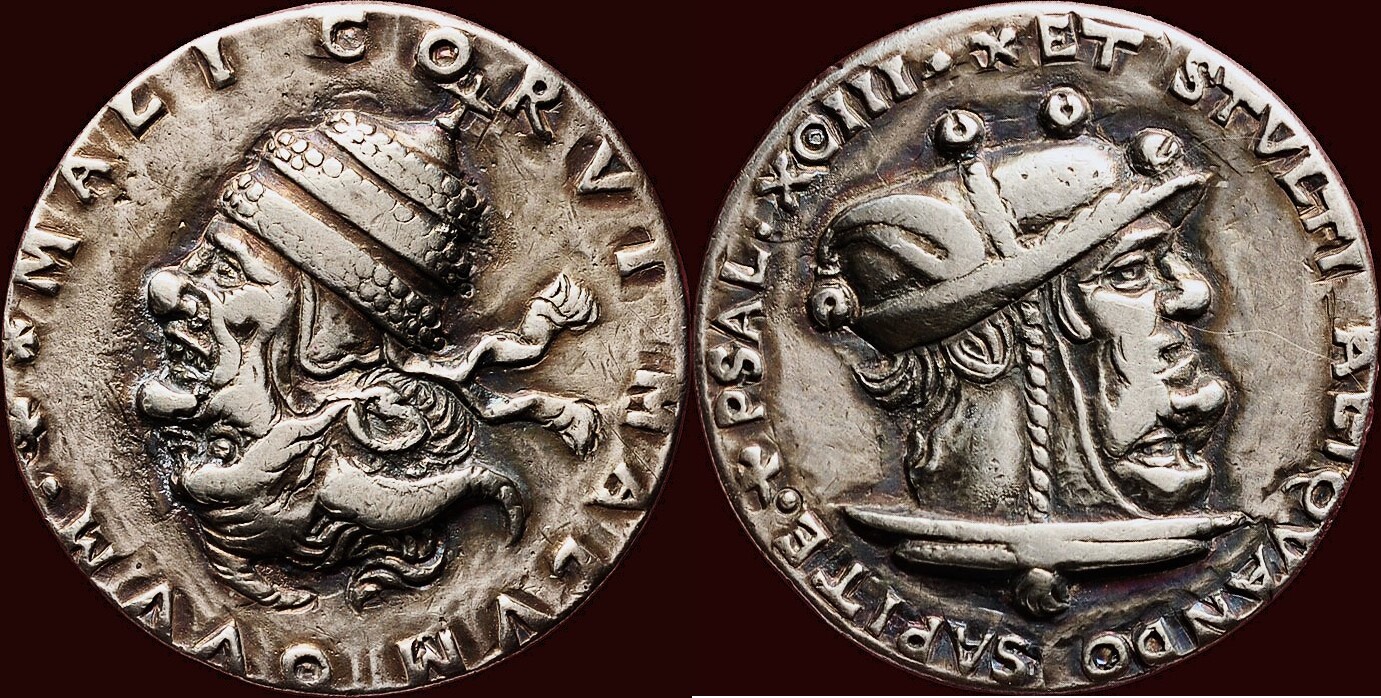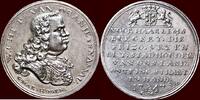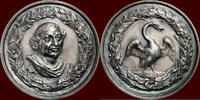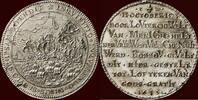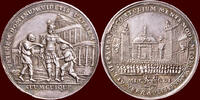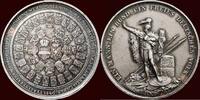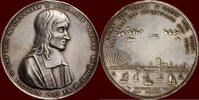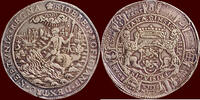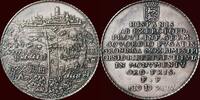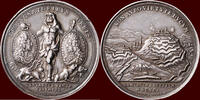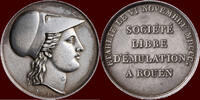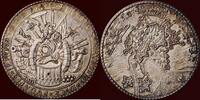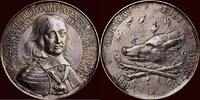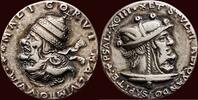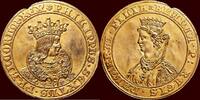MA-ID: 8067602010
Customer feedback Henzen
Schnelle Lieferung. Super Ware. Vielen Dank!
O.K.
perfekt !!!
Great coin, quick delivery, thanks!
MEDAL GERMANY - ANTI-POPE SATIRICAL SILVER N.D. (ca.1540/1550) It concerns here a very early cast, executed in hi
Munthandel G.Henzen 

10
On MA-Shops since 10 years
7244 ratings,
100 % Positive (last 24 months)
Worldwide shipping
1,430.47 £1650,00 EUR
Import tax may be added
+ 24.27 £ shipping ( to United Kingdom )
Delivery time: 5 - 8 days
+ 24.27 £ shipping ( to United Kingdom )
| Customer Support +49 (0)2871 2180 383 |
| Payment methods |
| Wire Transfer |
It concerns here a very early cast, executed in hi | Abbreviations
Intelligite, insipientes in populo et stulti, aliquando sapite
29.00 mm
weight 16,28gr. | silver cast Ø 29mm.
medalist: Friedrich Hagenauer (?)
(German, born Strasbourg, 1490–1500, died after 1546)
design: Nikolaus von Amsdorf (?)
obv. Head of Pope (l) coupled with head of Devil (r),
surrounded by the legend ✱ MALI CORVI MALVM O •✱
(translation: Bad Egg from a Bad Crow)
rev. Head of Cardinal (l) coupled with head of Jester (r), surrounded
by the legend x ET STVLTI ALIQANDO SAPITE .+PSAL•XCIII
(translation: and, you fools, be wise at last, Psalm 93)
This reverse inscription is taken from the Bible, the second half of Psalm 23:8 in the Vulgate: Intelligite, insipientes in populo et stulti, aliquando sapite which the Douay-Rheims version translates as "Understand, ye senseless among the people: and, you fools, be wise at last." It is generally accepted that the Protestant Reformation began in 1517 when Martin Luther nailed his Ninety-Five Theses to the door of the All Saints′ Church in Wittenberg, Germany, in which he protested many practices of the Catholic Church, in particular the sale of indulgences. The movement spread throughout Europe, most notably by Ulrich Zwingli (in Switzerland) and John Calvin (initially in France, later in Switzerland), but also by several other Protestant reformers. It encompassed most of Europe, gaining its strongest adherents in Northern Europe: Germany, Switzerland, Scandinavia, England, Scotland, The Netherlands. The movement was largely concluded in 1648 with the Peace of Westphalia, which ended one hundred thirty-one years of consequent European religious wars. This European Christian reform movement established Protestantism as a constituent branch of contemporary Christianity. The medal shown here is one of several issued during this period to support the Protestant movement by ridiculing the hierarchy of the Roman Catholic Church. This satirical medal, when rotated at 180 degrees changes the pope, now portraying him as the devil the figure of the cardinal, on the reverse, when rotated is converted into a jester or fool. The Latin inscription on the obverse can be translated in various ways, but generally suggests that if the parent (Pope) is evil, the children (his followers) are evil also. The phrase is derived from an ancient Greek anecdote from the fifth century BC. Barnard notes that the first medals depicting the pope and cardinal were positive images issued during the Reformation by the Roman Catholics in which the rotated images showed another view of each figure in different garb. Later the Protestants of Germany, Holland and Switzerland issued similar satirical medals, but now scurrilous, as the rotated images depicted the Pope as a Devil and the Cardinal as a Fool. Barnard goes on to note: "Many of these medals have been pierced, or provided with loops, for suspension, to facilitate wearing by enthusiasts of either party. Human nature, too, being what it is, we may conjecture that it was sometimes found useful to carry about a pair of rival badges. Displayed by Catholics in a Protestant district, or vice versa, they would probably save the wearer much trouble".
Again Barnard, quoting Klotz, states that the Pope-Devil and Cardinal-Fool types of medals date from between 1537 and 1547 and may have been designed by Luther′s friend Nikolaus von Amsdorf.
It concerns here a very early cast, executed in high relief and with fine details.
The work of a real artist medalist. Rare. cf. Whiting 47 | cf. Mitchiner, Medals 3018
beautiful specimen in high relief of this famous historical medal
vf/xf
medalist: Friedrich Hagenauer (?)
(German, born Strasbourg, 1490–1500, died after 1546)
design: Nikolaus von Amsdorf (?)
obv. Head of Pope (l) coupled with head of Devil (r),
surrounded by the legend ✱ MALI CORVI MALVM O •✱
(translation: Bad Egg from a Bad Crow)
rev. Head of Cardinal (l) coupled with head of Jester (r), surrounded
by the legend x ET STVLTI ALIQANDO SAPITE .+PSAL•XCIII
(translation: and, you fools, be wise at last, Psalm 93)
This reverse inscription is taken from the Bible, the second half of Psalm 23:8 in the Vulgate: Intelligite, insipientes in populo et stulti, aliquando sapite which the Douay-Rheims version translates as "Understand, ye senseless among the people: and, you fools, be wise at last." It is generally accepted that the Protestant Reformation began in 1517 when Martin Luther nailed his Ninety-Five Theses to the door of the All Saints′ Church in Wittenberg, Germany, in which he protested many practices of the Catholic Church, in particular the sale of indulgences. The movement spread throughout Europe, most notably by Ulrich Zwingli (in Switzerland) and John Calvin (initially in France, later in Switzerland), but also by several other Protestant reformers. It encompassed most of Europe, gaining its strongest adherents in Northern Europe: Germany, Switzerland, Scandinavia, England, Scotland, The Netherlands. The movement was largely concluded in 1648 with the Peace of Westphalia, which ended one hundred thirty-one years of consequent European religious wars. This European Christian reform movement established Protestantism as a constituent branch of contemporary Christianity. The medal shown here is one of several issued during this period to support the Protestant movement by ridiculing the hierarchy of the Roman Catholic Church. This satirical medal, when rotated at 180 degrees changes the pope, now portraying him as the devil the figure of the cardinal, on the reverse, when rotated is converted into a jester or fool. The Latin inscription on the obverse can be translated in various ways, but generally suggests that if the parent (Pope) is evil, the children (his followers) are evil also. The phrase is derived from an ancient Greek anecdote from the fifth century BC. Barnard notes that the first medals depicting the pope and cardinal were positive images issued during the Reformation by the Roman Catholics in which the rotated images showed another view of each figure in different garb. Later the Protestants of Germany, Holland and Switzerland issued similar satirical medals, but now scurrilous, as the rotated images depicted the Pope as a Devil and the Cardinal as a Fool. Barnard goes on to note: "Many of these medals have been pierced, or provided with loops, for suspension, to facilitate wearing by enthusiasts of either party. Human nature, too, being what it is, we may conjecture that it was sometimes found useful to carry about a pair of rival badges. Displayed by Catholics in a Protestant district, or vice versa, they would probably save the wearer much trouble".
Again Barnard, quoting Klotz, states that the Pope-Devil and Cardinal-Fool types of medals date from between 1537 and 1547 and may have been designed by Luther′s friend Nikolaus von Amsdorf.
It concerns here a very early cast, executed in high relief and with fine details.
The work of a real artist medalist. Rare. cf. Whiting 47 | cf. Mitchiner, Medals 3018
beautiful specimen in high relief of this famous historical medal
vf/xf
Please respect our order minimum of 20 Euros. For EU only IBAN payment please. Shippings to China are on risk of the buyer and only payment by bankwire or WISE. Shipping will take place within 5 days after receipt of payment. Sendings to Russia,Ukraine and Israel are not possible. Additional administration- and risk costs for PayPal & creditcard payments. No PayPal or creditcardpayments possible for orders over 10.000 euro.
| Shipping fees | ||||
|---|---|---|---|---|
| up to 86.70 £ | 86.70 £ to 433.48 £ | 433.48 £ to 866.95 £ | over 866.95 £ | |
| Argentina | 27.74 £ | 27.74 £ | 34.68 £ | 34.68 £ |
| Australia | 30.34 £ | 30.34 £ | 34.68 £ | 34.68 £ |
| Belgium | 8.24 £ | 9.54 £ | 11.27 £ | 15.61 £ |
| Brazil | 47.68 £ | 47.68 £ | 47.68 £ | 47.68 £ |
| Bulgaria | 12.14 £ | 13.87 £ | 30.34 £ | 39.01 £ |
| Chile | 43.35 £ | 43.35 £ | 43.35 £ | 43.35 £ |
| China | 34.68 £ | 34.68 £ | 43.35 £ | 43.35 £ |
| Denmark | 9.97 £ | 11.27 £ | 13.87 £ | 17.34 £ |
| Germany | 8.24 £ | 9.54 £ | 11.27 £ | 15.61 £ |
| Estonia | 11.27 £ | 12.14 £ | 13.00 £ | 21.67 £ |
| France | 8.24 £ | 9.54 £ | 13.87 £ | 21.67 £ |
| Greece | 13.00 £ | 21.67 £ | 26.01 £ | 30.34 £ |
| United Kingdom | 21.67 £ | 21.67 £ | 22.54 £ | 24.27 £ |
| Hong Kong | 34.68 £ | 34.68 £ | 43.35 £ | 43.35 £ |
| India | 30.34 £ | 30.34 £ | 34.68 £ | 43.35 £ |
| Indonesia | 30.34 £ | 30.34 £ | 34.68 £ | 34.68 £ |
| Israel | 173.39 £ | 173.39 £ | 173.39 £ | 173.39 £ |
| Japan | 34.68 £ | 34.68 £ | 34.68 £ | 34.68 £ |
| Cambodia | 56.35 £ | 56.35 £ | 56.35 £ | 56.35 £ |
| Canada | 26.01 £ | 26.01 £ | 30.34 £ | 30.34 £ |
| Liechtenstein | 17.34 £ | 17.34 £ | 21.67 £ | 21.67 £ |
| Luxembourg | 9.54 £ | 11.27 £ | 13.87 £ | 21.67 £ |
| Malaysia | 30.34 £ | 30.34 £ | 34.68 £ | 39.01 £ |
| Netherlands | 7.37 £ | 7.37 £ | 9.54 £ | 12.14 £ |
| Norway | 21.67 £ | 21.67 £ | 26.01 £ | 30.34 £ |
| Austria | 9.97 £ | 10.84 £ | 13.00 £ | 21.67 £ |
| Poland | 11.27 £ | 12.14 £ | 14.30 £ | 21.67 £ |
| Portugal | 11.27 £ | 12.14 £ | 15.61 £ | 21.67 £ |
| Romania | 13.87 £ | 15.61 £ | 21.67 £ | 30.34 £ |
| Russian Federation | 173.39 £ | 173.39 £ | 173.39 £ | 173.39 £ |
| Switzerland | 26.01 £ | 26.01 £ | 34.68 £ | 34.68 £ |
| Serbia | 21.67 £ | 21.67 £ | 26.01 £ | 30.34 £ |
| Singapore | 30.34 £ | 30.34 £ | 30.34 £ | 34.68 £ |
| Slovakia | 11.27 £ | 13.00 £ | 17.34 £ | 21.67 £ |
| Spain | 9.97 £ | 11.70 £ | 14.30 £ | 21.67 £ |
| Sri Lanka | 30.34 £ | 30.34 £ | 34.68 £ | 39.01 £ |
| Czech Republic | 10.40 £ | 12.14 £ | 15.61 £ | 21.67 £ |
| Ukraine | 173.39 £ | 173.39 £ | 173.39 £ | 173.39 £ |
| Hungary | 12.14 £ | 13.87 £ | 21.67 £ | 26.01 £ |
| United States | 27.74 £ | 27.74 £ | 30.34 £ | 34.68 £ |
| European Union | 13.00 £ | 14.74 £ | 21.67 £ | 26.01 £ |
| World | 34.68 £ | 34.68 £ | 43.35 £ | 43.35 £ |
Information
Online orders are welcome as always and will be shipped directly.
|
Seller Home | 0Shopping cart | Terms of sale | Contact | MA Terms of sale | Privacy policy | Warranty | MA-Shops New Items Copyright ® 2001-2025, MA-SHOPS Coins All Rights Reserved. Designated trademarks and brands are the property of their respective owners. |
 Buy coins with warranty
Buy coins with warranty



